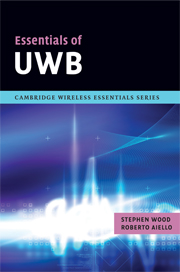Book contents
- Frontmatter
- Contents
- 1 Introducing ultra-wideband (UWB)
- 2 Matching UWB to HDR applications
- 3 Physical-layer (PHY) characteristics
- 4 Media-access control (MAC) layer
- 5 Implementation information
- 6 Upper-layer protocols
- 7 Ultra-wideband standardization
- 8 Special-interest groups
- 9 Ultra-wideband business issues
- 10 Regulating ultra-wideband
- 11 Tragedy of the commons
- Appendix: Reference documents
- Author biographies
- Index
- References
2 - Matching UWB to HDR applications
Published online by Cambridge University Press: 22 August 2009
- Frontmatter
- Contents
- 1 Introducing ultra-wideband (UWB)
- 2 Matching UWB to HDR applications
- 3 Physical-layer (PHY) characteristics
- 4 Media-access control (MAC) layer
- 5 Implementation information
- 6 Upper-layer protocols
- 7 Ultra-wideband standardization
- 8 Special-interest groups
- 9 Ultra-wideband business issues
- 10 Regulating ultra-wideband
- 11 Tragedy of the commons
- Appendix: Reference documents
- Author biographies
- Index
- References
Summary
Any successful new technology can be described as a combination of features that allow the technology to perform a given application better than those technologies that precede it or that enable new applications to be performed. The consumer has the final word in the success of a technology. If the product that manufacturers are trying to sell to the consumer does not convey a strong sense of benefit or sex appeal, the product becomes a wallflower on the back of store shelves.
In this chapter, the discussion will centre on the features of UWB, a comparison of these features with competing technologies and the emerging applications that demand the improved performance that UWB provides. With UWB, the principal features of interest include speed, cost, location resolution and power consumption. Each of these characteristics will be covered separately.
Speed – specifying UWB
The exciting new applications that are emerging now or will emerge over the next few years will demand, more than any other single attribute, extremely fast speed. Speed is required for one of two reasons. Either the application involves a large file transfer, such as the download of a Blueray DVD (50 GB), [1] or high-resolution video streaming (Displayport up to 11 Gbps). [2] In the case of large file transfers, speed translates into consumer wait time.
- Type
- Chapter
- Information
- Essentials of UWB , pp. 19 - 36Publisher: Cambridge University PressPrint publication year: 2008



